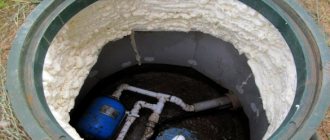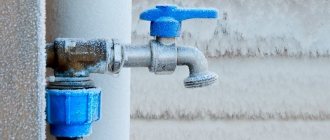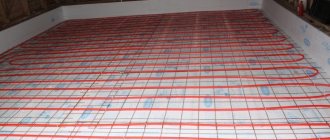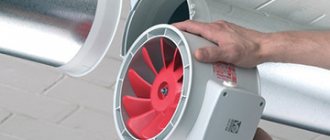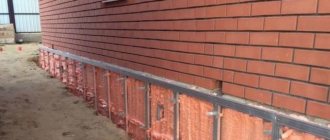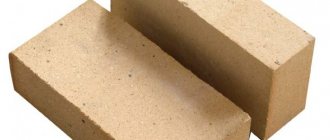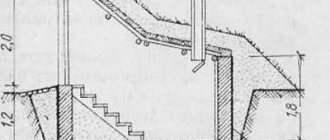Prepare your lawn for winter
The first step is to clear the lawn of debris. A layer of fallen leaves or branches will inhibit photosynthesis and can also provide an excellent home for pathogens and pests. The lawn also needs to be mulched to preserve the sown grass and reduce moisture evaporation. Do not forget about cutting the grass - this procedure in the middle zone can be carried out until the end of October. Moreover, the mowing height should be 1-2 cm higher than usual (i.e., if during the season you cut the lawn to 4 cm, now the grass height should be 5-6 cm).
In the first half of October, do not forget to feed the lawn with phosphorus-potassium or special autumn lawn fertilizer (according to the instructions). If holes and bald spots have formed on the cover, they need to be “patched” by adding soil and sowing seeds.
Check the well
The well does not require special preparation for winter. But if the water has acquired an unpleasant odor of hydrogen sulfide (the smell of rotten eggs) or a cloudy sediment, cleaning and disinfection measures must be taken. You can probably handle a small well (2-3 rings) on your own. Using a drainage or pump pump, pump out the water, go down into the well, and clean the walls of dirt. Then disinfect the well.
To disinfect a well, you can use tablets designed to purify pool water. They are dissolved in a bucket of water (1 tablet per 1 well ring), then the mixture is poured into a well filled with water and left for 6-8 hours. After this, the water is pumped out again.
If you clean the well in the fall, it will not be necessary to do this in the spring - regular disinfection is sufficient.
How to drain water from a toilet for the winter
Preparing the toilet
- Flush the toilet tank several times, turn off the water supply to the toilet tank and flush the water from the tank. unscrew the lid of the tank and make sure that there is almost no water left in the tank; if you wish, you can remove the remaining water with a rag or sponge (this is not necessary if there is not much water left in the tank).
- Scoop out as much water as possible from the toilet bowl.
- It is best to use a special scoop for this, made with a wallpaper knife from a plastic bottle, shaped like a ladle.
- However, you can scoop out water using any available means. Remove any remaining water from the bowl with an old rag or sponge.
To prevent odors from the sewer network from entering the house in winter, tightly plug the hole in the bowl with a rag. You can also throw some rags on top and even close the lid, although this is not necessary.
Video: instructions: draining water for the winter in a double house
The water in the toilet is frozen, how can I defrost it?
I would like to immediately note that there should be no water in the toilet tank if it is a toilet in an outdoor toilet, or a toilet in a house that is not heated. It (water) is simply not needed there; no one uses the toilet.
To prevent the smell of sewage from penetrating into the room, the toilet (structurally) has a “siphon” which provides a water seal.
Prepare the water supply
The water supply system at the dacha is especially vulnerable in winter, so you need to take care of its safety in advance. If you do not plan to use it in winter, then the water from the pipes will have to be drained. To do this, you need to turn off the water supply and open the drain taps at the lowest points so that the water comes out by gravity. If there are no drain valves, use an auto compressor. To blow out the pipes in your dacha for the winter, close all the valves on the manifold and attach a compressor to the pipe. Then you need to create a pressure of 3-4 atmospheres and open one of the collector taps - under air pressure, water will come out of the pipe. Repeat the procedure with each line.
To protect the pipeline outdoors and in unheated rooms, leave the valves slightly open and dismantle the mixers. Also remember to drain the water from the filters.
If the pipes are not buried deep enough, they must be insulated. To do this, place sheets of expanded polystyrene or polystyrene over the place where the pipes pass and secure it by pressing it down with bricks and digging it in.
Preparing the toilet.
The largest water plug in terms of volume is in the toilet, and this is understandable - the largest traffic is through the toilet. In addition to the fact that this plug is the largest, it is located in the elbow of the ceramic toilet bowl, which has very low deformation properties. Simply put, when the water in the toilet bowl freezes, the bottom of the knee simply breaks off. Sometimes this happens very nicely and neatly, so that the broken part can be glued back in place, but it’s better not to take risks.
When preserving a dacha for the winter:
- flush the water from the toilet tank several times,
- Shut off the water supply to the toilet tank and flush the water from the tank.
- unscrew the lid of the tank and make sure that there is almost no water left in the tank; if you wish, you can remove the remaining water with a rag or sponge (this is not necessary if there is not much water left in the tank).
- Scoop out as much water as possible from the toilet bowl. It is best to use a special scoop for this, made with a wallpaper knife from a plastic bottle, shaped like a ladle. However, you can scoop out water using any available means.
- Remove any remaining water from the bowl with an old rag or sponge.
- To prevent odors from the sewer network from entering the house in winter, tightly plug the hole in the bowl with a rag.
- You can also throw some rags on top and even close the lid, although this is not necessary:
Treat basement and cellar for mold
The end of the summer season is the right time to treat the cellar and basement so that a “mold kingdom” does not develop in them over the winter. First of all, in dry weather, take all the jars outside and dry the room, and then treat the walls and other structures with an antiseptic (this procedure must be repeated every few years).
As an antiseptic, you can use a solution of copper sulfate (100 g per 1 liter of water).
Those who like to solve problems in a radical way recommend using a sulfur smoke bomb to treat the basement. Seal all ventilation holes in the empty room, cover metal parts (if any) with polyethylene. Check that there is no one in the house (you will have to leave it for a day), and then light the fuse of the checker, go out and close the doors tightly. Upon return, thoroughly ventilate all areas.
Communities Boys and Girls Blog How to protect the toilet from defrosting without draining it
Treat basement and cellar for mold
The end of the summer season is the right time to treat the cellar and basement so that a “mold kingdom” does not develop in them over the winter. First of all, in dry weather, take all the jars outside and dry the room, and then treat the walls and other structures with an antiseptic (this procedure must be repeated every few years).
As an antiseptic, you can use a solution of copper sulfate (100 g per 1 liter of water).
Those who like to solve problems in a radical way recommend using a sulfur smoke bomb to treat the basement. Seal all ventilation holes in the empty room, cover metal parts (if any) with polyethylene. Check that there is no one in the house (you will have to leave it for a day), and then light the fuse of the checker, go out and close the doors tightly. Upon return, thoroughly ventilate all areas.
Best answers
Before dismantling the toilet, flush the water in the usual way. then they shut off the pipe supplying the tank with water and take out the insides. If you forgot to drain, now you only have to scoop it up with a ladle.
Guy from the Future Future:
Should you drain the water from the tank or from the toilet itself? If from the tank, then simply turn off the water and press (pull) the drain. If from the toilet itself, then this is called a water seal (water plug so it doesn’t stink). You can drain the water from the water seal anywhere after dismantling the toilet. Or you don’t have to drain it.
First, turn off the water in the drain tank, then drain all the water from the tank, remove the flexible line and use a jar or scoop to scoop up water. How much can you drain? Then unscrew the fastening screws, remove the toilet corrugation and completely drain the water from the toilet.
If there is no separate valve for the toilet, then turn off the common one. Drain the tank, unscrew it and do what you need to do. There is no need to block the sewer - it is at an angle (pipe) and will not trample back. Just cover it with a rag so it doesn't stink.
I didn’t flush it at all - you just tilt the toilet towards the fan and the excess will drain out on its own, then carefully not tilting it too much to the side)...
Can't find a light?:
It won’t spill out anywhere—on the contrary, you’ll have to tilt it, gently holding it in your arms.
don't do what you don't know. Doing repairs for neighbors is a troublesome task
First, turn off the common valve in the apartment so that water does not flow into the toilet cistern.
Then drain the water from the tank, and only then remove the toilet.
IF YOU FORGOT TO DRAIN THE WATER FROM THE TANK -
there are only 5-10 liters of water - drain it into any sink or bucket,
You can also take a bath - the water is clean.
PLACE IT DIRECTLY INSIDE THE BATH WITHOUT TILTING.
THEN TILT AND EVEN TURN IT UP so it all comes together.
If you forgot water in the toilet itself, there are about TWO liters of water there.
Drain in the same way.
How can we make this into a catastrophe on a universal scale?
Entrust the matter to a specialist. Otherwise you'll drown your neighbors
When you unscrew it from the floor, tilt it towards the pipe, some of it will spill out, but you can take it out without incident.
Turn off the water to the flush tank, drain all the water from the tank, remove the tank, you can scoop the water out of the toilet, just soak it up with a rag and squeeze it out, then remove the toilet itself, maybe a little water will remain, no problem
turn to the specialists of ct-servis /services/kanalizaciya who will come, salt, remove, what needs to be trimmed, installed and use it for your health))) in such things, I try to entrust everything to those who do this professionally, change the mixer, light bulb or socket - it’s easy... but here... I wouldn’t risk it myself))) then scoop up the poop from yourself and from your neighbors, and then there’s someone to blame it on later)))
It’s strange that no one said about communicating vessels: First, as always, turn off the water and press the flush button to empty the tank.. Then take any flexible hose, for example an old flexible hose from a tap about a meter long, so that one end can reach the bottom toilet, hung over the top of the toilet and the second reached to the bottom of the bucket (to the floor). Pour a full hose of water from the tap. Close either end with your finger so that the water does not spill out. Immerse the end not covered with your finger into the toilet; lower the end closed with your finger into the bucket to the very bottom and release your finger .The water will flow from the toilet into the bucket. When the water stops flowing, raise the end of the hose from the toilet higher so that all the water goes into the bucket.
Exchange contacts with neighbors
If you still don’t know your neighbors in your summer cottage, correct this immediately. This is necessary not only to fit into the framework of social etiquette, but also for mutual assistance “in case something happens.” Exchange phone numbers or other contact information with your neighbors. Agree to contact each other if you suspect something is wrong with a neighboring property.
In addition to all of the above, do not forget about the flower garden: dig up and store perennial plants that require it, cover roses and other flowers. Read about what else needs to be done in the garden in our material:
Preparing the toilet.
The largest water plug in terms of volume is in the toilet, and this is understandable - the largest traffic is through the toilet. In addition to the fact that this plug is the largest, it is located in the elbow of the ceramic toilet bowl, which has very low deformation properties. Simply put, when the water in the toilet bowl freezes, the bottom of the knee simply breaks off. Sometimes this happens very nicely and neatly, so that the broken part can be glued back in place, but it’s better not to take risks.
When preserving a dacha for the winter:
- flush the water from the toilet tank several times,
- Shut off the water supply to the toilet tank and flush the water from the tank.
- unscrew the lid of the tank and make sure that there is almost no water left in the tank; if you wish, you can remove the remaining water with a rag or sponge (this is not necessary if there is not much water left in the tank).
- Scoop out as much water as possible from the toilet bowl. It is best to use a special scoop for this, made with a wallpaper knife from a plastic bottle, shaped like a ladle. However, you can scoop out water using any available means.
- Remove any remaining water from the bowl with an old rag or sponge.
- To prevent odors from the sewer network from entering the house in winter, tightly plug the hole in the bowl with a rag.
- You can also throw some rags on top and even close the lid, although this is not necessary:
Protect your home from rodents
Mice in the countryside in winter can damage furniture and other property. To protect your country house from small rodents, we recommend using special repellers. Their advantage over traditional mousetraps is that the animal will not die - it will simply bypass your house. Agree, there is little pleasure in arriving at the dacha and finding mousetraps with the remains of rodents in the house.
Pour stocks of pasta, cereals and other potential mouse delicacies into sealed glass or metal jars in advance.
Preparing the toilet.
The largest water plug in terms of volume is in the toilet, and this is understandable - the largest traffic is through the toilet. In addition to the fact that this plug is the largest, it is located in the elbow of the ceramic toilet bowl, which has very low deformation properties. Simply put, when the water in the toilet bowl freezes, the bottom of the knee simply breaks off. Sometimes this happens very nicely and neatly, so that the broken part can be glued back in place, but it’s better not to take risks.
When preserving a dacha for the winter:
- flush the water from the toilet tank several times,
- Shut off the water supply to the toilet tank and flush the water from the tank.
- unscrew the lid of the tank and make sure that there is almost no water left in the tank; if you wish, you can remove the remaining water with a rag or sponge (this is not necessary if there is not much water left in the tank).
- Scoop out as much water as possible from the toilet bowl. It is best to use a special scoop for this, made with a wallpaper knife from a plastic bottle, shaped like a ladle. However, you can scoop out water using any available means.
- Remove any remaining water from the bowl with an old rag or sponge.
- To prevent odors from the sewer network from entering the house in winter, tightly plug the hole in the bowl with a rag.
- You can also throw some rags on top and even close the lid, although this is not necessary:
Take care of your TV
If you are not afraid to leave the TV at the dacha in winter, prepare it for your long absence. Remove the batteries from the remote control (they may leak), disconnect all cables from the device and pack the TV in dry material (cloth, paper).
Household appliances should not be left near heating appliances.
When you come to your dacha in winter, do not plug in the TV right away - it needs time to “warm up”. Otherwise, a short circuit may occur due to condensation accumulated inside.
Wash and dry everything
Yes, it’s not just basements that are susceptible to mold. In an unheated house, the humidity is high, so take care to ventilate the rooms. Pillows, blankets, bed linen, curtains, tablecloths - all this should be washed and dried. When putting clean items in the closet, line them with silica gel (in bags) and scented sachets (juniper or lavender branches are also suitable) to prevent the fabric from becoming damp.
Before leaving for the city, oil the keyholes and door hinges so that the doors open normally in the spring.
Remove tools and building materials
Surely every summer resident has a secluded corner in his yard, in which lie boards, beams, pipes and other building materials, waiting “in the wings.” It's time to sort through the “stocks”. Conduct an audit - perhaps something needs to be thrown away? Rotting boards and cracked pipes are unlikely to be useful to you on the farm. Place the remaining building materials under a canopy or treat them with an antiseptic and cover them loosely with film to protect them from rain. Garden tools and put them in the utility room. Useful tips on storing garden tools await you in our materials:
Take care of protecting your home
Unfortunately, the reality is that there are no fewer people wanting to make money at other people’s expense. Holiday villages are still at risk when it comes to theft. Unscrupulous “comrades” are ready to grab not only obviously valuable things, for example, equipment, but in general everything that is “badly lying” (and sometimes not lying at all, but literally dug into the ground). What to do? There are enough options: alarm system, video surveillance, bars on windows, high-quality locks and high fences.
Exchange “contacts” with neighbors
If you still don’t know your neighbors in your summer cottage, correct this immediately. This is necessary not only to fit into the framework of social etiquette, but also for mutual assistance “in case something happens.” Exchange phone numbers or other contact information with your neighbors. Agree to contact each other if you suspect something is wrong with a neighboring property.
In addition to all of the above, do not forget about the flower garden: dig up and store perennial plants that require it, cover roses and other flowers. Read about what else needs to be done in the garden in our material:
toilet water seal in winter
I'm starting to make a sewer system at my dacha with summer residence. I make a septic tank separately for the toilet. a 100mm pipe from the septic tank goes to the toilet, then turns into a 50mm pipe and along the back wall of the house goes up 6 meters for ventilation and ends with a fungus. Due to the fact that I don’t yet plan to use the toilet in winter, a number of questions have arisen regarding preservation for the cold period. To prevent the toilet from defrosting, the water from the valve must be drained or replaced with non-freezing liquid. My concerns: if you remove (bail out) the water, will the smell from the septic tank go into the room and not into the ventilation pipe? If you fill in an antifreeze liquid (and it should be inexpensive), then when you first use the toilet in the spring, will it end up in the septic tank and destroy all its bacteria? What do you advise? and the 50k pipe won’t become clogged with frost from the septic tank fumes? (although this is not scary, it will thaw in the spring) do not offer electric heating - what if the electricity is turned off, but here in Siberia it can be below minus 40
Scoop out the water and plug the hole with a rag.
I thought about this method, but the rag is not airtight, it will probably smell a little, well, I’ll try it. And as a follow-up question, how much water is in the toilet seal? this is if you replace it with alcohol or vodka.
I guess it will evaporate. If you push a rag into a plastic bag, and then this gag into the hole, everything will be fine.
2zvv60 “Spit” some polyurethane foam into the plastic bag and insert it into the hole in the toilet. Get the “plug” exactly along the contour.
zvv60 wrote: this is if you replace it with alcohol or vodka.
The homeless will come to the smell
A gag made of a rag, or in a PE bag. You can try to find a children's ball in size.
This is exactly what is advised in all manuals on septic tanks. The water is sucked out with a water vacuum cleaner; if there is no such thing, then with an ordinary sponge. Any rag will do for the plug; there will be no smell. Don’t forget to first drain all the water from the system and leave all (!) taps in the open position.
RAMAZ wrote: and leave all (!) taps in the open position.
Ball in half open – handle at 45 degrees
BV wrote: Ball in half open - handle at 45 degrees
I support - I have the bitter experience of leaving taps in the OPEN position in the garden. The result was that the taps burst on the sides. The next year I bought new ones. Then, in connection with the reconstruction of the irrigation system, I sealed these taps and still use them.
The student wrote: I think it will evaporate. If you push a rag into a plastic bag, and then this gag into the hole, everything will be fine.
As for several plastic bags with injected polyurethane foam - I use it myself in different situations = an excellent stopper. The size will be perfect. You just have to SPIT ENOUGH. And from experience, I collect sewage into a DIRECT drain. Those. at 110 mm the central one runs in the basement through the entire house to the other side. There is an antifan plug there. And if you need to clean and rinse the pipe, just open this plug and use even an inch pipe with a brush to clean and rinse easily. The pipe runs with a constant slope - for this I place a beam on an edge 150 * 50 and the length of the entire house. You can sew on both sides if it is short. This is from an old experience: my father-in-law’s drain was clogged, and he had a 50 mm steel pipe - that’s when I expressed myself in kind words. I had to fix everything and assemble it according to the above diagram. It was cool when they dropped a piece of floor rag with a bucket of dirty water - just push it from the side of the plug and it’s done. And if it were the old way, then the entire dictionary would have been shoveled.

